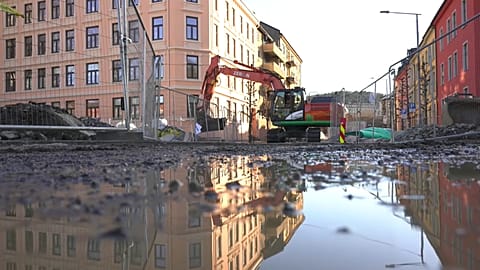A recent report has identified 38 jobs that are lacking workers, and 37 that have too many. Is yours on the list?
While many people have difficulty finding a job in Europe, others work in sectors that are struggling to find enough candidates.
When the demand for workers outstrips the supply of job seekers - or when there are too few people qualified, available, and willing to do the job - the labour market faces shortages.
What are the most in-demand occupations?
Workers for jobs in software, healthcare, construction and engineering are some of the most sought-after, the latest report from the European Labour Authority has shown. The 2022 study analysed the situation in the 27 countries of the European Union as well as Norway and Switzerland.
Of around 400 identified occupations, 38 were assessed as having widespread shortages. That means that at least 11 countries reported them as such. Around 38.82 million workers in the surveyed countries are employed in these jobs.
Fifteen jobs from the list are related to construction. Bricklayer is the profession cited by the highest number of countries, closely followed by carpenter and joiner. On the operative level, the list features occupations like earthmoving and related plant operators as well as building labourers. Civil engineers are also included in the list.
Not surprisingly, many of the engineering jobs where there are widespread shortages are also related to construction, such as welders, structural metal preparers and erectors.
The list also features in-demand software occupations such as software developers, applications programmers, systems analysts, software and applications developers and analysts.
The health sector features prominently, with general practitioners and specialists, nursing professionals, psychologists, physiotherapists, and healthcare assistants forming part of the list.
From the hospitality sector, the most sought-after workers are cooks, waiters and waitresses, bakers, pastry cooks and confectioners. Butchers, fishmongers and related food preparers are also in high demand.
Another important finding is that most of the occupations listed experienced a level of shortage rated as severe. The jobs with the highest percentage of countries classifying them as such are psychologists, painters, heavy truck and lorry drivers as well as agricultural and industrial mechanics.
Are these job shortages going to last?
Many of the occupations featured in the list are part of a five-year trend, meaning they are persistent rather than temporary. Jobs like bricklayers, heavy truck drivers, plumbers, nurses, welders, building electricians, software developers, cooks, doctors, and motor mechanics, feature in the top 10 rankings in all four previous reports.
However, some of the jobs on the list are new. Psychologists and physiotherapists have made the list for the first time. Medical specialists made their first appearance in 2021 while healthcare assistants have been mentioned since 2020 - the year of the COVID-19 pandemic - and have featured ever since.
As for the hospitality sector, the staffing issues faced by many countries are not a new phenomenon. However, with the exception of cooks - who appeared on all previous rankings - all the other hospitality-related jobs are new. Waiter, butcher, baker and fishmonger appear for the first time.
Shortages related to current events, such as the war in Ukraine or the COVID-19 pandemic, can abate over time. However, the situation can be more complex if the shortage has existed over a longer period. This, for example, is the case for software-related jobs, which regularly appear in this report.
Which countries are the most affected by shortages?
The report shows that shortages are mostly concentrated in northern and western Europe, although a considerable number have also been registered in Italy.
Switzerland, Italy and the Netherlands have the highest number of shortages in the identified occupations, while Greece, the Czech Republic and Malta have the fewest.
Why are shortages happening?
The labour market has undergone many changes in recent decades. Several factors are behind this labour imbalance. Technological changes, Europe’s ageing population, the transition to a greener economy, and recent events such as the war in Ukraine and the COVID-19 pandemic have all played a part.
New technologies and digital skills
New digital technologies are transforming most sectors of the economy and more occupations require STEM (science, technology, engineering, and mathematics) qualifications.
Europe’s ageing population
Europe's population is ageing and its share of working-age people (aged 20-64 years) is also projected to decrease from 59 per cent to 50 per cent by 2100. This is having social and economic consequences. The health and social care sector needs more workers but is struggling to attract new people and retain existing staff due to deteriorating working conditions. A new report from the International Council of Nurses (ICN) warns that the worldwide shortage of nurses could lead to a global crisis in the coming years.
This demographic change is also having an impact on the construction sector, as buildings and homes need to be adapted in order to meet the needs of older people.
Europe’s climate goals
Europe wants to move towards a climate-neutral economy, as well as a circular one, which has implications for the way goods are produced and consumed.
The European Green Deal is supposed to create more than 480,000 jobs in the European Union by 2030. An analysis by Eurofound in 2021, revealed that the Green Deal could lead to labour shortages in agriculture, manufacturing, construction, energy, transport, professional and scientific services, tourism, and education.
While the report states that the balance between supply and demand for green skills is relatively good at present, it cautions that the supply of workers with the required skills is not sufficient to meet Europe's green targets in the years ahead.
The COVID-19 pandemic
Europe appears to be struggling to meet the labour demands that emerged during the COVID-19 aftermath. The rapid increase in economic activity once restrictions were lifted caused demand to outstrip supply. This has particularly affected sectors such as hospitality and construction.
In addition, European employers in various sectors also reported that many of their workers did not return to their pre-pandemic jobs, leading to shortages in many occupations.
Other factors, such as supply chain disruptions and, more recently, the energy crisis caused by the war in Ukraine, can also lead to labour imbalances.
What is the profile of workers in shortage jobs?
Overall, most of those employed in shortage occupations tend to have a medium level of education and more technical qualifications. While many shortages affect skilled jobs - such as healthcare workers, skilled construction or information and communication technologies - others concern a relatively modest level of qualification, such as cleaners.
Women are one of the groups most affected by these labour imbalances. In 2021, 46 per cent of the labour force in the EU27 were women, but only 34 per cent worked in the most widespread shortage occupations. If healthcare occupations were removed, women would account for only 14 per cent of the list of widespread shortages.
The situation is even worse when we look at the most widespread surplus occupations, where 62 per cent of those employed are women.
So... Where are the surpluses?
The same report identified 37 occupations as experiencing widespread surpluses. This concerns around 39.88 million workers in the European Union, Norway and Switzerland.
The list features professional, clerical, and elementary occupations. There are many jobs related to the creative arts and humanities, but there are also receptionists, general secretaries, office clerks, and library and stock clerks.
Featuring in the top 10 were graphic and multi-media designers, administrative and executive secretaries, general office clerks, shop sales assistants and secretaries. These were joined by interior designers and decorators, journalists, elementary workers, car, taxi and van drivers and photographers.
No STEM professions were included in the list.

















